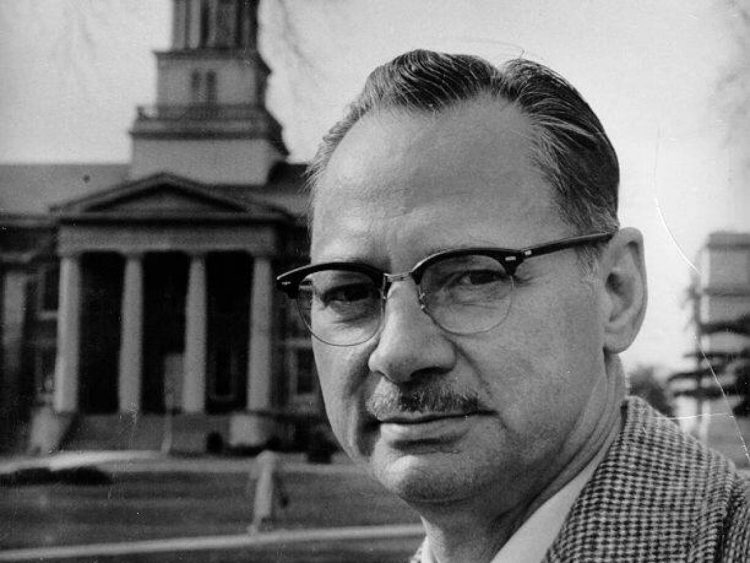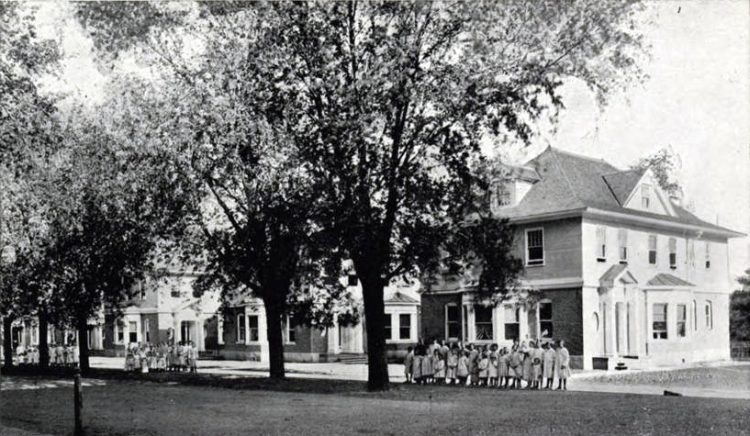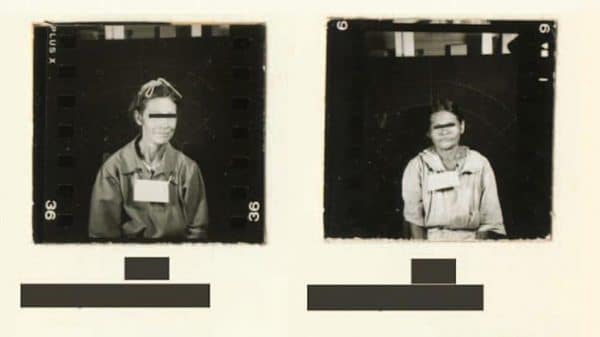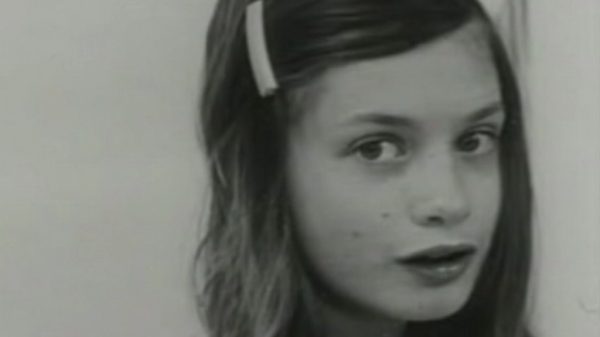Text: Jim Dyer via San Jose Mercury News
By the summer of 1939, 12-year-old Mary Korlaske was stuttering so badly that she thought it was fortunate that Mary Tudor had given her speech therapy. She didn’t know that it hadn’t been therapy at all.

Tudor had been a graduate student at the University of Iowa, and Korlaske had been part of an experiment. The experiment, on 22 children living at the Iowa Soldiers’ Orphans’ Home in Davenport used psychological pressure to induce children who spoke normally to stutter. It was designed by one of the nation’s most prominent speech pathologists, Dr. Wendell Johnson, to test his theory on the cause of stuttering.
Mary Korlaske remembers that she had thought her sessions with Tudor were sponsored by the university to help her speak better. She had also hoped the pretty graduate student would become her new mom.
As her speech worsened, her behavior changed.
She remembers other orphans teasing her: “Hey, Mmmmary. Wwwwwhat’s gggggoing on?” Furious, she would strike out, pummeling with her fists.
“She was always fighting kids,” said Dolly Hamer Sweeney, Mary’s best friend at the orphanage. “She didn’t like to be made fun of.” Sweeney, now 75 and living in Southern California, had a brother who stuttered and was included in the experiment as part of a control group.
The more Mary fought, the more the children teased her. She grew to hate the orphanage. Her grades fell. She rarely spoke. She felt a ringing desperation to be alone. One day she found a way to climb into the attic of her cottage. It was dark and quiet. She sat for hours on the dusty planks, gazing out the window at the other children.
That summer a boy made fun of classmate Dorothy Ossman’s stuttering, and Mary slugged him. The girls became instant friends. Mary didn’t know it, but 14-year-old Dorothy, who had been a severe stutterer all her life, had been Case No. 9 in the experiment.
Mary showed Dorothy her secret hideaway in the attic and it became their refuge. They played with the old clothes stored there, brought up fruit they raided from an orchard and consoled each other.
Korlaske says she especially remembers one day in the attic. That day, Dorothy was crying over the teasing. Mary handed her friend a cherished keepsake her mother had given her when she sent her away to the orphanage — a silver thimble, etched with forget-me-nots.
“It’s my tiny cup for tears,” she said. Dorothy said the thimble wouldn’t be big enough for the tears of both of them. So Mary took it and rammed it against a nail protruding from a beam. She showed Dorothy the hole in the bottom.
“Now it’ll never overflow,” she said. The girls laughed.

Attempt at a fix: Damage hard to reverse
After the experiment ended, Mary Tudor moved to Wisconsin. Several months later, officials at the orphanage became alarmed about the children’s speech and contacted Wendell Johnson.
Johnson asked Tudor to evaluate the children and to try to reverse the effects of the experiment using positive therapy.
“If I possibly can, I want to go down to the orphanage during Christmas vacation because I believe it would be very interesting to see them after this length of time has elapsed,” Tudor replied in a letter in December 1939.
She finally managed the daylong trip in March 1940, and was shocked by the deterioration of the children’s speech, especially that of 11-year-old Clarence Fifer and 15-year-old Hazel Potter.
“I didn’t find them as free from the effects of the therapy I had inflicted upon them last year as I had hoped to,” she wrote to Johnson. “But as I am still a firm believer in the theory of evaluative labeling, I wasn’t too disappointed.”
Letters between Tudor and Johnson show she returned to the orphanage two more times to attempt reverse therapy.
On Jan. 3, 1941, she received a final letter from Johnson. The principal had told him that Hazel Potter, Case No. 16, had left the orphanage, her speech “quite bad.”
Tudor never made it back to the orphanage.
By spring, Mary Korlaske and Dorothy Ossman had given up any hope of happiness at the orphanage or of escape through adoption. So they decided to run away. Mary put on an old shirt and pants she found in the attic, tucked her curly hair under a baseball cap and ran off with her friend. They hitchhiked west and then north to Mary’s hometown of Emmettsburg, where Mary found her mother.
“Keep the thimble to remember me,” Mary remembers telling Dorothy. “I’ve got my mom back.”
The next day, Mary sat with her mother beside a lake north of town and soaked up the afternoon, fishing and talking. She didn’t notice the men approaching.
“Are you Mary Korlaske?” a police officer asked.
“No,” Mary said, bolting up to run away. Her mother gently grabbed her arm.
“Yes, she is,” her mother told the officers.
The police took Mary away, to a county jail, and charged her with being a runaway.
Later that day, officers brought in Dorothy Ossman on the same charges.
Mary felt desolate at the thought of returning to the orphanage. Dorothy tried to cheer her up. She reached into her pocket, then handed her friend the silver thimble.
“In case you need it,” Dorothy said.
The next day they learned the orphanage would not take them back. Deemed chronic runaways because of Dorothy’s history of unsuccessful attempts, they were taken to a higher security state training school for girls, where they spent the war years.

A coverup: Methods questioned
When the United States entered World War II, Mary Tudor joined the Navy. She returned to Iowa in 1945. After four years as a procurement officer, she was eager to resume her career as a speech therapist.
Tudor looked forward to seeing Wendell Johnson again; she hoped he would help her find a job. Six years earlier, she remembered, he had grown increasingly excited over her progress reports on the stuttering experiment. The research supported his groundbreaking theory on the cause of stuttering. Tudor had submitted her thesis before the war broke out.
But when she contacted her adviser after the war, she found the once warm and friendly man cold and dismissive.
“It was clear he didn’t want me around,” Tudor recalled. “He was worried I’d tell somebody.”
During the war years, some of his graduate students, concerned about the ethics of the orphan study, had begun calling it the “Monster Experiment” or the “Monster Study.” They warned him that although the experiment was hardly unique in having used orphans as subjects, it was a particularly sensitive time: In the aftermath of World War II, observers might draw comparisons to Nazi experiments on human subjects, which could destroy his career.
“This was the kind of stuff you would think they were doing in Auschwitz, and this is why, at that time, people concealed it,” said Franklin Silverman, a student of Johnson’s who became a professor of speech pathology at Marquette University in Milwaukee. “They wanted to block it out of their minds and make believe it didn’t happen.”
The experiment had become an embarrassment to Johnson, said Bill Trotter, a retired speech pathology professor at Marquette who also studied under Johnson. “I heard some of the orphans didn’t recover,” he said. “But I know Wendell Johnson was an extremely ethical and moral person, and if something happened to those children it was because of something he did not foresee.”
Johnson’s embarrassment collided with an overwhelming sense of accomplishment for having obtained direct evidence for his theory, said Dave Williams, a professor emeritus of communicative disorders at Northern Illinois University, who studied speech pathology under Johnson after the war.
“It was a very conflictive situation for him,” said Williams, a severe stutterer himself. “He didn’t know how to react to it or handle it.”
It created a predicament. Publishing his theory that calling attention to stuttering is one of the causes of the disorder could help millions of children as well as elevate his status in the world of speech pathology. But using the experiment as direct evidence could destroy his career.
So Johnson never published Tudor’s thesis nor mentioned it in any of his writings. He forwarded his theory citing other, indirect evidence: Anthropologists had reported that certain Indian tribes had no word for stuttering and were more relaxed about their children’s speech development, and had no stutterers.
“The Indian children were not criticized or evaluated on the basis of their speech, no comments were made about it, no issue was made of it,” Johnson wrote in his seminal 1946 book “People and Quandaries.”
By the late 1940s, his “diagnosogenic theory” became the most widely accepted theory on the cause of stuttering. In magazines and newspapers around the world, parents were encouraged to let their children work out their speech repetitions themselves and not draw attention to them.
Johnson corresponded with hundreds of people all over the world who sought his advice. A severe stutterer for decades, he had become quite fluent. He found he could speak in front of crowds without stuttering, and his lectures on speech problems attracted full houses across the country.
When he died in 1965 at the age of 59, thousands of letters arrived in Iowa City celebrating his life’s work. In 1968, the University of Iowa founded the Wendell Johnson Speech and Hearing Center, which remains one of the nation’s leading institutes for speech pathology and audiology.
“Wendell Johnson was a most revered and universally loved man,” said Dr. Duane Spriestersbach, a colleague and close friend who gave Johnson’s graveside eulogy.

Positive therapy: Applying the theory
When Mary Tudor found herself cold-shouldered by Johnson, she took a job at the local veterans’ hospital. Soon after, she married and took up her career as a speech therapist again.
For 34 years, she worked in school districts, first in Iowa and later in California. She read Johnson’s books and was one of the many therapists who used his techniques.
In the experiment, Tudor had subjected half the children to criticism to make them self-conscious about their speech, eventually driving most of them to stutter. With the other children — those in control groups — she used positive therapy, supporting and encouraging them whether they spoke fluently or not.
As a school speech therapist, Tudor used only the positive therapy, she said. She would speak in a gentle, supportive tone.
“You’re doing so much better,” she remembers telling a quiet first-grader in Salinas in the early 1960s. “You’re reading so well.”
“I know,” he replied. “You cured my voice.”
She found the therapy successful and taught teachers and parents about Johnson’s diagnosogenic theory. She never mentioned the experiment.
But sometimes, she remembers, she would sit in a tiny chair next to a child who was struggling to read aloud and be reminded of the orphans who had sat across from her, wide-eyed and eager to participate.
Ends vs. means: Assessing science
For years, Tudor, 84, had rationalized the experiment to herself, saying it ultimately helped many people.
Then, three months ago, a letter and package arrived from Mary Korlaske.
“I remember your face, how kind you were and you looked like my mother,” the letter said. “But you were ther to destroy my life.”
The letter, full of misspelled words seemingly scratched in fits and bursts, called her “monster” and “Nazi.”
Tudor was stunned. “I don’t like to be characterized as an uncaring, cold person, because I’m not,” she said.
“You see, it was an assignment for me. It was a different world then. You did what you were told. If I got the same assignment today, I wouldn’t do it, now that I’m a mother and grandmother.”
Tudor looks back at what happened in 1939 at the orphanage as an aberration in her life.
For medical science, however, it was not an aberration. In the early 1900s, physicians in North Carolina, Pennsylvania and Ohio injected dozens of orphans with syphilis and tuberculosis in experiments. Shortly before the stuttering experiment, the University of Iowa conducted other studies at the orphanage, including one that studied the effects of stimulation deprivation on intelligence.
More widely known experiments used other kinds of vulnerable patients without informing them. One of the most notorious was the Tuskegee syphilis experiment, which ran from 1932 to 1972 and in which doctors in the U.S. Public Health Service studying syphilis denied treatment to 399 poor black sharecroppers so they could document the disease’s progression. In another government-sponsored study, 18 patients at various hospitals were injected with plutonium in the late 1940s to see how the radioactive chemical spread through the body.
When experts try to evaluate the ethical implications of such experiments, they consider several elements: What was the ultimate value of the experiment? How much harm did it cause the subjects? What were the ethical standards for human experimentation at the time? Was enough done to reverse the negative effects?
A small circle of speech pathologists have been aware of Johnson’s stuttering experiment for many years. Most agree that the “Monster Study” provided direct evidence for Johnson’s theory, which changed the way people regarded stutterers and opened the door to effective therapies. But a few reject the theory, in part because they find the experiment’s methodology imprecise and subjective.
Ehud Yairi, a professor of speech and hearing at the University of Illinois and a former student of Johnson’s, said labeling someone a stutterer may worsen an existing problem, but the objective data in the experiment did not support Johnson’s theory.
“There was a motivation to prove a theory,” Yairi said, speculating that some of Tudor’s conclusions may have been swayed by a desire to prove her adviser’s theory.
Johnson’s theory dominated until the 1970s, when speech pathologists began to reexamine its premise. Anthropologists had discovered that those Indian tribes not only had words for stuttering, but also had stutterers. Meanwhile, some therapists had noticed that some children continued to stutter even though no one criticized their speech.
Gradually, Johnson’s theory fell out of favor and speech pathologists began moving back to organic causes to explain stuttering.
Even today, though, Johnson’s theory underlies the widely held view that positive reinforcement is the best therapy for children with speech problems.
For the past decade, a handful of speech pathologists who know about the experiment and support Johnson’s theory as one explanation for stuttering have started to think it might be necessary to publicize the experiment. They fear that a growing number of experts want to revert to the idea that stuttering is inborn and therefore that it is best to make children acutely aware of their speech problems.

But they are torn: Revealing the truth in order to save Johnson’s theory could prove costly to his reputation.
“Johnson was viewed as a god, the Monster Study suggested that he had feet of clay,” said Silverman, who reported on the experiment in a 1988 speech pathology journal. “The study should not have been done. But since it was done and someone could benefit from the research, we should utilize it.”
Many are troubled that Johnson — a man plagued by stuttering his entire life — would see the need to induce it in children, especially orphans.
Scientifically, using the orphanage for research was advantageous because it supplied a large, homogeneous group of children. Moreover, Johnson didn’t need parental permission — something that probably would have been denied.
“I think it’s not coincidental that he chose to do it with a group of parentless kids,” said Tricia Zebrowski, 45, an assistant professor at the Wendell Johnson Speech and Hearing Center in Iowa, who heads the speech pathology and audiology program established by Johnson. “This was the only way he was going to get kids.”
Johnson’s prolific writing provides little insight into his thoughts on using the orphans. There are almost three dozen boxes of Johnson’s records stored at the University of Iowa library, including his opinions on subjects from politics to soil erosion, and wide-ranging correspondence with such luminaries as Albert Einstein.
Yet the box filled with meticulously alphabetized files of graduate students who worked under him includes no file on Mary Tudor. His 1939 journal mentions his meetings with Tudor and his trip to the orphanage to witness the final assessments, but nothing more. Anything else he may have written about the experiment could not be found.
In the same journal, Johnson wrote about his concern that his son would become a stutterer. His son was 5 years old — almost the same age as the youngest orphan induced to stutter in the experiment. “Bothered by the thought Nicky will notice and imitate my repetitions,” he wrote.
Now a law professor at the University of Iowa, Nicholas Johnson, who does not stutter, would not discuss what his father might have thought about the orphans. Standards were different in the 1930s, he said. His father was universally beloved, and when he died, thousands of people from around the world who benefited from his therapy sent letters to his family, he said.
And Mary Tudor doesn’t know how her professor regarded the treatment of the orphans. “I don’t know why Wendell Johnson didn’t send a therapist from the university over to the orphanage,” she said. “They needed therapy to lose that fear, or the psychological effects could be long-lasting. Wendell Johnson would know that you couldn’t reverse it in three sessions of positive therapy.”
Reversing both the stuttering and the anxiety and isolation stemming from stuttering is much more difficult than creating it, said Chandler Screven, a former professor of childhood psychology at the University of Wisconsin-Milwaukee.

Screven, who studied under Johnson, likened the orphans’ dilemma to that of laboratory rats that receive electric shocks when they hear a buzzer and jump over a barrier in response. Once the animals have been conditioned to jump, those connections remain in their brains. Over time, they may fade, but all it takes is a traumatic event — a trigger — and they quickly resurface.
“The original connections,” he said, “are always there.”
In assessing the harm caused by Johnson’s experiment, some experts point out that it is hard to separate the damage caused by being labeled stutterers from that caused by other adversities the orphans faced, such as severe poverty, the loss of a parent, a childhood in an institution.
For Duane Spriestersbach, a close colleague of Johnson who went on to become a professor of speech pathology and disorders of the ear, nose and throat at the University of Iowa, the orphan experiment was both justified and ethical.
“It was a different time and the values were different,” he said. “Today we might disagree with what he did, but in those days it was fully within the norms of the time.”
In fact, in its 1936 biennial report, the Iowa State Board of Control, which oversaw all state institutions, openly encouraged and reported on cooperation with the University of Iowa in conducting research using children in various institutions.
But Susan E. Lederer, a medical historian and author of “Subjected to Science: Human Experimentation in America before the Second World War,” said there were numerous codes regarding such experimentation at that time. “There were implicit rules, if not explicit rules, in place, particularly when it comes to inducing a pathology in children.”
James Holmes, superintendent of the orphanage in Davenport in the 1950s and 1960s, was appalled when he heard about Johnson’s experiment. “The state must have known about it,” Holmes said. He, too, had approved research at the orphanage conducted by the university, but he was required to inform the state board of control and ensure that he would follow up on the research.
Zebrowski, who refers to the orphan experiment in her courses on stuttering therapy and research, said that Johnson’s work made a great contribution by showing that stuttering results from a complex interaction of internal and external factors, and that the desperation to avoid stuttering can make the problem worse.
“Anybody who knows of it or hears about it now would interpret it as a harmful study, that these people were sort of monsters to these little kids,” she said. “No, it wasn’t ethical. Do I know why he did it? No. Do I think he was a bad person? No. I just think it was the culture at the time.”
“The real litmus test,” she said, “is what happened to those children.”

A traumatic event: Relapse triggered
The trigger for Mary Korlaske Nixon came in 1999 when, two days before New Year’s Day, her husband died.
She had met him in Iowa in 1954, where she settled after a decade of wandering from state to state. He was a tall, outgoing man who never made fun of her speech or lack of education. He encouraged her to socialize.
“I’m proud of you,” she remembers him telling her. “Don’t let people put you down.”
They married and raised three children. Her speech improved. She forgot about the orphanage. She remembers her life with him as 45 years of happiness.
Then he died, and she started to stutter again.
Her oldest son, Jimmy Madden of San Bruno, grew worried.
“I didn’t know what was wrong,” he said. “She had problems talking before sometimes but this was bad.”
She tried applying the techniques Mary Tudor had taught her at the orphanage during the experiment, techniques she had been told were therapeutic. She stopped, took a deep breath. She placed her tongue on the roof of her mouth. They didn’t help.
She began to withdraw. She moved into the Iowa Veterans Home in Marshalltown and placed a “Do Not Disturb” sign on her door. She stocked her room with food, crafts, soda and videotapes, and for months she rarely left.
“When she first came here, she said, `I’m a loner and my room is my private place,’ ” said Doug Moberly, a social worker at the home.
Last year in May, at her granddaughter’s wedding in Palo Alto, she sat in the far corner of the hotel’s reception hall. “When can I go home?” she repeatedly asked her son.
At Christmas, she could endure only about five minutes of the annual party before she returned to her room.
“I don’t know what’s wrong with me,” she told a reporter who visited her during the first week of January.
A revelation: Anger, sorrow, relief According to Mary Tudor’s records, the last time anyone contacted the orphans in connection with the experiment was August 1940, when Tudor made her last visit to the orphanage. Six decades later, a search that began with her records identified 20 of the 22 orphans, of whom at least 13 are still alive.
They had never heard about the experiment. When the Mercury News told them, most became angered by the experiment. Some responded stoically. Others cried.
“Oh, dear God,” said Donna Hughes Collings of Des Moines, who had been a normal speaker in a control group and therefore suffered no damage. Her husband held her while he lambasted the people responsible, comparing them to the Nazis saying, “The end never justifies the means.”
Others just stared, incredulous. “Why? Why would they do that to us?” asked Ralph Fry of Nora Springs, Iowa. He had been a stutterer, was placed in a control group and given positive therapy, and his speech improved.

Some were not surprised.
“We knew they were experimenting on us,” said Hazel Potter Dornbush, 77, of Fulton, Ill. At 15 years of age, Hazel, a normal speaker induced to stutter, had been one of the oldest subjects. “Every week somebody else from the university would come and start testing us for God knows what.”
Others, like Robert Hamer, 73, of Waterloo, Iowa, listened long and hard before commenting. He was a stutterer included in a control group and retained somewhat halting speech. “They might not have known the negative effects beforehand,” he said. “If they knew, then it was wrong.”
Jane Ann Pugh Fleming, a normal speaker who had been in a control group and now lives in Milwaukee, at first refused to listen to anything about the experiment. “I don’t even want to know,” she said, shaking her hand in front of her face and ushering the reporter out of her home.
For her younger sister, Norma Jean Pugh, learning about the experiment came as an epiphany. At 6, she had spoken fluently, but was induced to stutter in the experiment. She suffered for years, wondering why she found it so hard t o be with people.
“At least I know it’s not me,” she said. Now going by the name Kathryn Meacham, she moved from foster family to foster family during her childhood, repeatedly rejected because they considered her a misfit and slow in school. She remembers how classmates teased her about her stuttering.
“My speech bothered me as a young child,” she said. “The kids were cruel.”
Now 68, she lives as a recluse in her tiny town of Linden, Iowa, the one who never attends high school reunions, who never leaves her home, who rarely talks to anyone except her children.
When Mary Korlaske Nixon was told about the experiment, she was stunned. She stared, her smoky blue eyes fixed on every word.
Of the six normal speakers induced to stutter, she retained the most noticeable speech repetitions. She has difficulty with words that begin with “s” and sometimes repeats words in her sentences. When she is nervous, her words jumble and she struggles to get them out.
“It’s affected me right now,” she said. “I don’t like to read out loud because I’m afraid of making a mistake. I don’t like talking to people because of saying the wrong word.”
The orphanage “was a cruel place, but I didn’t realize they was pulling that on me.”
She remembered many of the children in the experiment, including her friend Dorothy, who died last year, and Marian Higdon, who she learned had been her control group counterpart.
“I don’t like what they did to me, but I’m glad it was me,” she said. “Marian might not have been able to handle it. I’m a fighter. I’ll make them pay for what they did to us.”
Love and betrayal: A reminder in the mail
Mary Korlaske Nixon called a lawyer. She started contacting some orphans who were in the experiment. She called the University of Iowa to request a copy of Tudor’s unpublished thesis and current address.
She wondered, though, if any legal action would be resolved before she dies, and if she would ever again meet Mary Tudor, the woman she had once thought would be her new mother.
So, one night in early March, she took a pen and wrote a letter. She wrote about love and betrayal, about hope and despair, about God and forgiveness. Her bitterness spilled out.
She enclosed the letter with a small package wrapped in tissue and white medical tape.
A few days later, it arrived 1,700 miles away in the East Bay town of Moraga.
“Did you get married? Did you have children? Are they insignificant?” the letter said. “Why experiment on orphans, we have all ready had enough problems, and was unwanted. I have nothing left. You stolen my life away from me.
“As I sit her crying . . . I wondered what I could say or send you to remind you of the hurtful pain that never goes away.
“I’m sending you your own thimble.
“God try to have mercy, or should he? You had no mercy for the children who still cry in the night.
“– Mary Korlaske Nixon Case No. 15
“P.S. When the tears get realy bad, punch a whole in the bottom of the thimble like I did. Then the thimble won’t over flow.”
Mary Tudor, who so often had struggled with the right and wrong of that experiment so long ago, quietly set the letter down on her dining room table. She carried the package into the kitchen, pulled out scissors from a drawer, and began cutting through the medical tape.











